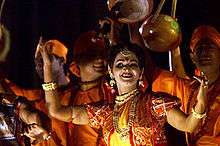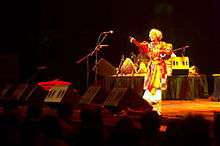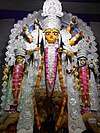Gombhira
Gombhira (or gambhira or gamvira) is a type of song originating in the Bengal region in the eastern part of the Indian subcontinent, what is today northwestern Bangladesh,[1][2][3][4][5] and northeastern West Bengal, India.
| Gombhira | |
|---|---|
 | |
| Stylistic origins | Maldah District |
| Typical instruments | Tabla |
| Music of Bangladesh | |
|---|---|
 | |
| Genres | |
| Specific forms | |
| Religious music | |
| Ethnic music | |
| Traditional music | |
| Media and performance | |
| Music awards | |
| Music festivals | |
| Music media | Radio
Television Internet |
| Nationalistic and patriotic songs | |
| National anthem | Amar Shonar Bangla |
| Other | Notuner Gaan (National March) Ekusher Gaan (Ode to the Language Movement) |
| Regional music | |
| Related areas | |
| Other regions | |
| Part of a series on the |
| Culture of Bengal |
|---|
 |
| History |
|
|
Mythology and folklore |
| Cuisine |
|
Festivals
|
|
Genres
Institutions
Awards
|
|
Music and performing arts Folk genres Devotional Classical genres
Modern genres
People Instruments Dance Theater
Organizations People |
|
Sport
|
|
|
Chapai Nawabganj District is the main centre of Gambhira performances in Bangladesh. The tradition is also popular in the nearby districts of Rajshahi and Naogaon.[3] In West Bengal, gombhira performances are centred around the Malda District. It is performed with a particularly distinctive rhythm and dance with two performers, always personifying a man and his maternal grandfather, discussing a topic to raise social awareness.
Gambhira mask
The Gambhira dance is performed all over the Malda district of North Bengal during the festival of Chaitra Sankranti. The masks are made out of neem and fig trees by the local Sutradhar community. Sometimes they were also made the mask of clay.[6] The three-dimensional crowns are the specialty of these masks. First, the facial features are carved out from a piece of wood and then coloured according to the character. This mask dance performed with Gombhira song. The songs of Gambhira originated among the Hindu community of Maldah in West Bengal, completely in its theme formation.[7]
See also
References
- Bangladesh. Calaccitra o Prakāśana Bibhāga (1988). Bangladesh Quarterly, Volume 8. University of California. pp. 4–8.
- A. F. Salahuddin Ahmed; Bazlul Mobin Chowdhury (2004). Bangladesh, national culture, and heritage: an introductory reader. Independent University, Bangladesh. pp. 407–410. ISBN 978-984-8509-00-5.
- Don Rubin; Chua Soo Pong; Ravi Chaturvedi; Minoru Tanokura; Ramendu Majundar (2001). The World Encyclopedia of Contemporary Theatre: Asia/Pacific. Taylor & Francis. pp. 78–86. ISBN 9780415260879.
- "Mango festival and cultural programme in Chapainawabganj". The Daily Star. Retrieved 2016-04-02.
- "Rajshahi University School, College wins divisional round". The Daily Star. Retrieved 2016-04-02.
- "The Mask". Biswa Bangla. Retrieved 2018-02-13.
- http://www.indianetzone.com/18/gambhira_dance_west_bengal.htm
